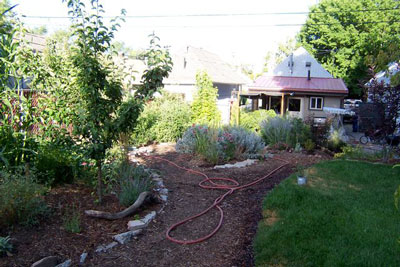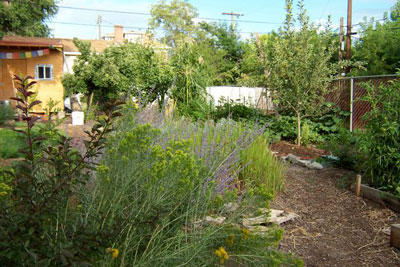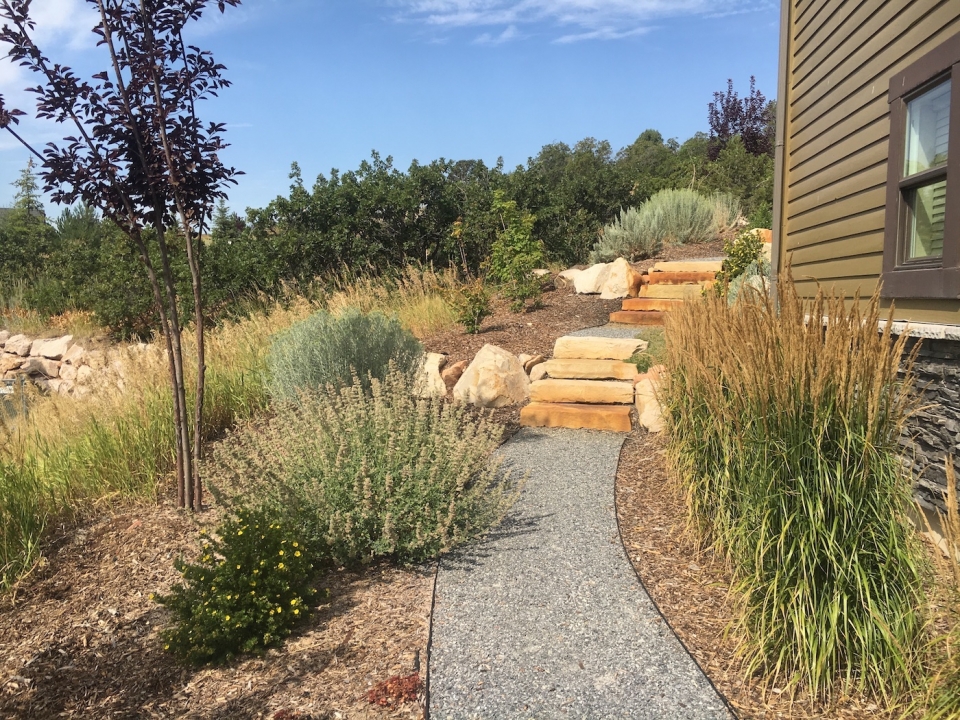The native landscape movement in Utah - otherwise known as xeriscaping - has been gaining popularity over the years. People are ripping up their water guzzling yards to replace them with drought tolerant perennials, shrubs, grasses and trees: all in the name of reducing their water consumption in the second driest state in the nation. And it’s exciting to see people working with nature instead of against it. But how else can we meet the needs of the environment as well as the people who live here, while deepening our relationship to the natural world and addressing ecological issues beyond just saving water in our yards. Welcome to permaculture.
Permaculture is an ecological design system using a set a principles and techniques for sustainable human settlements in urban, suburban and rural settings - in simpler terms, restoring our communities to a healthier and happier environment. Under the banner of permaculture you will find topics that include soil restoration, clean water, waste systems, ecoforestry, renewable energy systems, natural building methods, erosion control, urban food security and local economies. The list goes on. Not to mention the sub categories.
The word permaculture, meaning permanent cultures as well as permanent agriculture was conceived in the 1970's by Bill Mollison and his student David Holgrem. Through observing nature and how it provides and protects itself Bill and David developed a set of techniques that mimic this same design in man made landscapes. Guided by a set of ethical principles - care for the earth, care for the people, and return of excess to the first two - the goals of permaculture are to create ecological and sustainable communities. As stated by Dr. Mollison in 1978, "Sustainable is defined as a system, which over its lifetime produces energy equivalent to or in excess of what it consumes.
Why permaculture? How about drought, famine, desertification, soil erosion, urban expansion, over consumption of fossil fuels, and global warming to name a few. Brock Doleman, an ecologist and leading permaculturist states, that due to corporate industrialized agricultural practices, "enough top soil is being lost from U.S. crop lands to fill a cargo train wrapped around the earth every year." Worldwide, 40% of soils and water have been polluted by farming practices. So to combat this we increase the use of fertilizers, pesticides, herbicides, and fungicides. Therefore, the challenge for sustainable agriculture is to provide food and fiber while maintaining fertile soils, cleaner water and enhancing healthy ecosystems, with a smile on your face of course. Permaculturist look for positive and practical solutions to ecological problems.
 Some of these solutions include, planting guilds, water catchment, cover crops, animal husbandry, sheet mulching and food forests. Self reliance, less consumption and reducing our impact on the environment are the basis for these solutions as permaculture promotes using your surrounding area intensively to provide for your needs. The more productive the areas are, near your house, the more feasible it is to preserve the remaining natural forests and wildlife lands from destruction. And by implementing modern technology and using indigenous knowledge, a design can be as abundant as the ideas used to create it: not one plant, tree, animal or building stands alone, they all interconnect into a symbiotic relationship where all elements serve multiple functions. Companion plantings that provide insectary, nitrogen fixing, and edible elements are place together to support one another. Swales are dug to slow, spread and sink the rainfall on to your land. Trees are used to shade your house and reduce the electricity bill.
Some of these solutions include, planting guilds, water catchment, cover crops, animal husbandry, sheet mulching and food forests. Self reliance, less consumption and reducing our impact on the environment are the basis for these solutions as permaculture promotes using your surrounding area intensively to provide for your needs. The more productive the areas are, near your house, the more feasible it is to preserve the remaining natural forests and wildlife lands from destruction. And by implementing modern technology and using indigenous knowledge, a design can be as abundant as the ideas used to create it: not one plant, tree, animal or building stands alone, they all interconnect into a symbiotic relationship where all elements serve multiple functions. Companion plantings that provide insectary, nitrogen fixing, and edible elements are place together to support one another. Swales are dug to slow, spread and sink the rainfall on to your land. Trees are used to shade your house and reduce the electricity bill.
Imagine this: An empty plot of degraded land around your home, overgrown with thistle, cheat grass, morning glory and other ob-noxious invaders is cut down. Left in place to decompose, layers of recycled cardboard and wet newspaper are placed on top. More organic matter- manure, compost, leaves - is spread on top with a layer of straw or wood chips as mulch on top of that. Add some more compost, water, and behold you've just started to build soils all the while attracting worms, beetles and other microscopic creatures to aerate and till the soil for you. What, "no tilling or chemicals." That's right, you've just started to build your own soil in your backyard just like a forest that lays down its own fertile strata. Now it's planted. Conifers on the north side of the house to add a wind break from those chilly winter winds, which also reduce your heat bill: adds wildlife habitat and privacy from the neighbors as well. Deciduous trees on the west side of the house to provide shade from those late afternoon rays; again it adds privacy, maybe bares some fruit, holds moisture in the soil and provides nutrients to the perennials planted below it. More shrubs, perennials, vines and other trees planted to shade out the weeds, and keep the ground cooler in the suffer while offering edible fare for you and your wildlife guests. Swales are dug to intercept rain and ground water and aid in the plants growth. Grapes, clematis, hops, wisteria are planted to cover the arbor you eat lunch under (food from the garden of course). And in the late summer you can enjoy a few grapes for dessert without going far. A marsh, fed by the gray water from your sink, washer and showers, is planted with the essential accumulator plants to clean the water and then the overflow exits to a pond that was dug on the south side of your green house to reflect sunlight and aid in heating. Not to mention the aesthetic qualities and other diverse little creatures you've invited home. Sounds like sustainable hedonism to me.
 Penny Livingston, also known as the permaculture queen, has been teaching and designing these ecological systems around the globe. Her garden and home to the Northern California Permaculture institute in Point Reyes, California is much like the one I described. But some of it evolved differently as she tells the story. "After sheet mulching we planted a garden and then noticed the slugs we attracted. We needed something to get rid of the slugs so we got some ducks. The ducks then needed some water so we built a pond. I then had this pile of clay and at the time I was in need of more office space so we the office out of the clay using a method called cobb building. (Earthen homes) The roof on the office was then used to help reed rainwater into the pond, which then reflected the sunlight into the office." It somehow reminded me of the old lady who swallowed the fly story. Penny added, "If you have a problem, its not a pest problem it's a lack of predator problem." And predators abound in her garden. On several occasions as I awoke to the noises of fruit falling off the trees and critters making the most of the early dawn hours, my eyes focused on the blue heron fishing for what koi was left in one of the ponds. Her husband and fellow permie James laughed when I told him the start of my morning and said, "you don't need to go birdwatching when you can do it out your back door." Ten years later and what was once a field was now a flourishing self sustaining Eden.
Penny Livingston, also known as the permaculture queen, has been teaching and designing these ecological systems around the globe. Her garden and home to the Northern California Permaculture institute in Point Reyes, California is much like the one I described. But some of it evolved differently as she tells the story. "After sheet mulching we planted a garden and then noticed the slugs we attracted. We needed something to get rid of the slugs so we got some ducks. The ducks then needed some water so we built a pond. I then had this pile of clay and at the time I was in need of more office space so we the office out of the clay using a method called cobb building. (Earthen homes) The roof on the office was then used to help reed rainwater into the pond, which then reflected the sunlight into the office." It somehow reminded me of the old lady who swallowed the fly story. Penny added, "If you have a problem, its not a pest problem it's a lack of predator problem." And predators abound in her garden. On several occasions as I awoke to the noises of fruit falling off the trees and critters making the most of the early dawn hours, my eyes focused on the blue heron fishing for what koi was left in one of the ponds. Her husband and fellow permie James laughed when I told him the start of my morning and said, "you don't need to go birdwatching when you can do it out your back door." Ten years later and what was once a field was now a flourishing self sustaining Eden.
As stated in Bill Mollisons Permaculture Two, "it is a philosophy of working with nature rather than against it; of protracted and thoughtful observation rather than protracted and thoughtless action; of looking at systems and people in all their functions rather than asking only one yield of them; and of allowing systems to demonstrate their own evolutions." And so as you prepare your gardens and landscapes this Spring, take a good look at the natural world that surrounds you, do some experimenting, and transform your garden and yourself to new possibilities. With a good design you can begin to be part of the solution instead of part of the problem by providing for your needs locally. Permaculture starts with one garden at a time, do what you can and remember to smile while you lie in the hammock dreaming of what your ecological, self sustaining paradise will look like. Just remember to eventually get out of the hammock.

